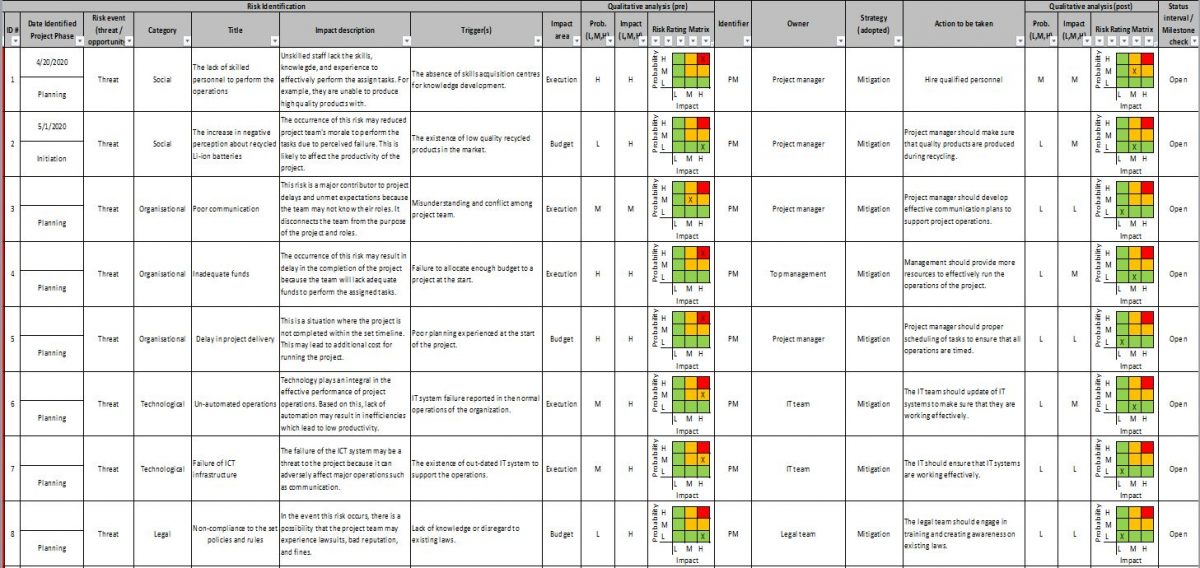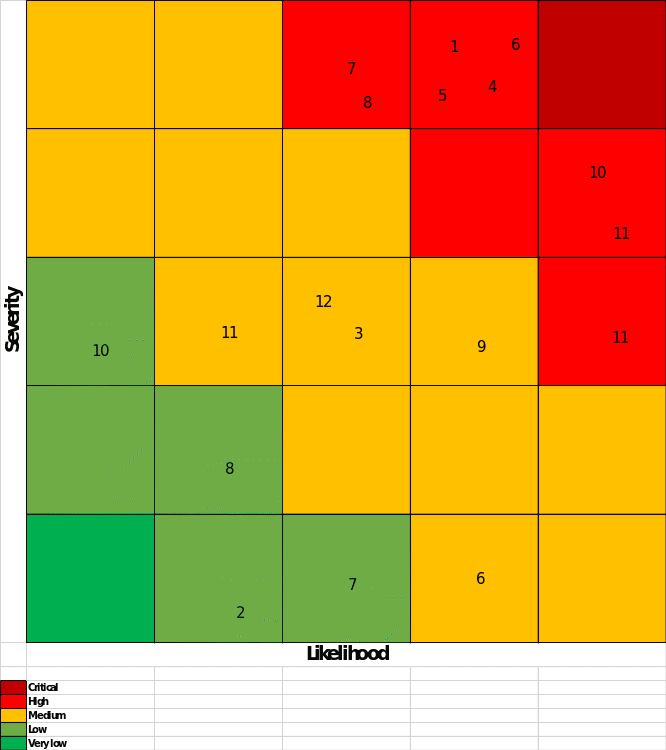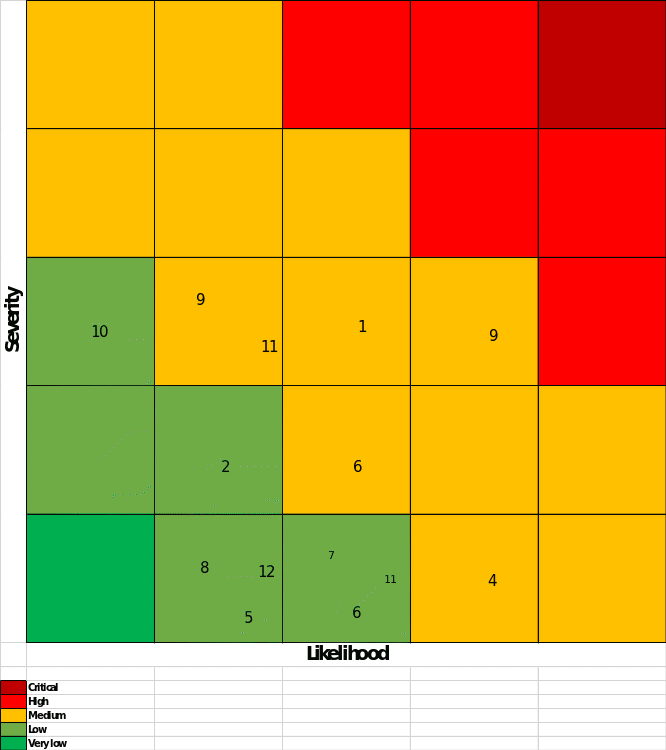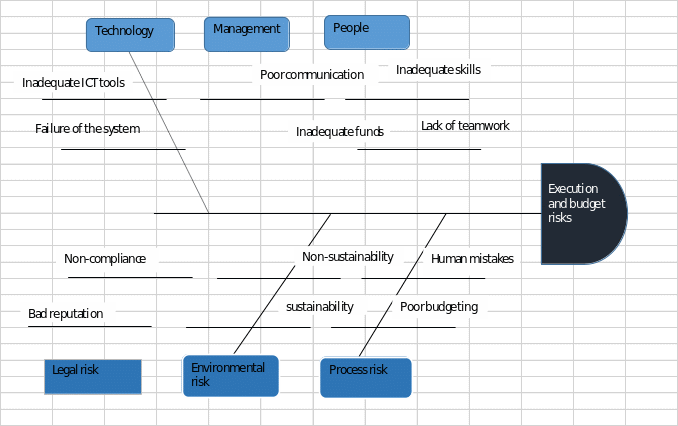STEEPCOIL is an important model used to categorize and identify risks. As shown in the table below, it separates risks based on social, technological, economic, environmental, political, commercial, organizational, information technology, and legal aspect (Steyn, 2018). In addition, the method is preferred because it categorizes risks in specific sections, which is integral during analysis. For example, some of the social risks to the project are the absence of skilled labor to effectively perform project operations. To achieve the intended goal, personnel who understand recycling Li-ion EV batteries need to be trained. Therefore, the STEEPCOIL framework helps in the classification of project risks for identification, analysis, and easy mitigation.
Technical and economic risks are some of the threats the project team should handle to achieve the anticipated goal. The technical component represents risks where the chosen technologies may not meet the project’s objectives (Steyn, 2018). It includes aspects like un-automated sorting of the EV batteries and inadequate innovation in the field of recycling. Economic and financial risks cover how well the venture will make money. For example, it looks at the equipment cost and the effect of schedule slippage (Masár et al., 2019). In this project, this category includes the perception that recycled Li-ion EV batteries are low quality compared to the new ones and high cost of materials used in the process. As a result, technical and economic risks can adversely affect the project’s productivity.
Environmental, political, and commercial risks should be addressed in this project. Political risks are risks that the project could suffer due to political decisions and instability (Steyn, 2018). It includes government decisions such as restriction of movement and increase in tax for products used to recycle Li-ion EV batteries. Environmental risks are the likelihood and consequence of an unwanted accident during the execution of this project. Some of these risks are bad weather, air pollution emanating from the process, and a threat to human health (Masár et al., 2019). Commercial risks include threats that could come up with contracts and lead to delays, higher costs, or lawsuits.
Organizational, information technology (IT), and legal risks are potential threats the project may experience. IT risks may adversely impact a project’s data, critical systems, and operations (Steyn, 2018). In this project, these risks include the failure of the IT infrastructure, such as a communication system to support the processes, and inadequate IT personnel. Organizational risks are aspects such as resources and culture which could impact the implementation of the project. It consists of poor communication, lack of teamwork, and inadequate funds to support the operations (Masár et al., 2019). Finally, legal risks are threats linked with the specific legal framework where the project must operate. Some of these risks include failure to adhere to existing policies and regulations.
STEEPCOIL Table
Risk Register
The risk register is the most important document in project management. As shown in the risk register below, the document contains information about identified risks outcome of risk analysis, such as likelihood, impact, and risk response plans (Masár et al., 2019). The first risk in the register is the lack of skilled personnel to effectively perform the assigned tasks. This risk is likely to occur and has a high impact on the project because it can lead to low productivity. However, the risk can be mitigated by outsourcing HR services and employing skilled personnel. The second risk on the register is the negative perception of recycled products. This can reduce the morale of the project team in performing their tasks. However, it can be mitigated by ensuring that the products meet the needs of stakeholders.
Additionally, some of the risks that have a high impact on the project are poor communication, inadequate funds, and delay in project delivery. Ineffective communication can lead to misunderstanding, conflict, and low productivity (Masár et al., 2019). This risk can be handled by developing effective communication plans and methodologies. For example, the project manager can come up with a plan documenting when and what communication tools to use. Lack of funds is a threat to the effective performance of the project. This risk may result in delays in the completion of the tasks. To mitigate this risk, top management should promote social acceptability to increase project funding. The other potential risk is the possibility of a delay in project delivery. The project manager can solve this by effective scheduling of tasks.
However, some of the risks with moderate impact on the project are non-sustainability and an unending increase in the price of materials used in recycling. Firstly, the project’s operations may be affected by non-sustainable project operations (Masár et al., 2019). For example, operations that do not support sustainability may lead to bad reputation or image. However, this can be mitigated by developing coping strategies for bad weather. Secondly, the constant rise in the price of supplies used in the project is a potential threat but has a moderate impact. It can be solved by conducting several surveys to understand the trend and develop an effective plan.
Table 1: Risk Register


Risk Heat Map: Pre-Mitigation Heat Map
A risk heat map is an important tool in managing risks, and is normally used to visually present the outcome of risk assessment in a meaningful and concise manner. Prior to mitigation, the map is likely to have risks that have high severity and likelihood of happening. For instance, as demonstrated in figure two, high severity risks are 1, 4, 5, 6, 7, 8, 10, and 11. The project team should mitigate these risks because they can lead to low performance (Masár et al., 2019). For example, a lack of skilled personnel to effectively handle project activities is highly likely to occur. On the other hand, the risk which has the potential to occur are 2, 6, and 7. Although these risks have low severity, they can hinder the progress of the project. Therefore, the project team should prioritize risks with high severity and then move to others.

Post-Mitigation Heat Map
Risk mitigation is a strategy used to reduce the effects of threats faced in a project. The approach involves developing preventive and reactive action plans for lowering the likelihood and severity of risks (Masár et al., 2019). After implementing mitigation strategies identified in the risk register, the impact of the risks is reduced, as shown in figure 3. For example, the risks that were severe and likely to occur changed to less severe and less likely to happen. Based on this, the project team should monitor the risks and adopt mitigation approaches. As a result, post-mitigation heat map outlines the result after the adoption of risk reduction strategies.

Ishikawa Diagram
Ishikawa diagram, commonly known as the fishbone diagram, is a visualization tool for categorizing the potential cause of a problem. As shown in figure 4, the main issue is the execution and budget risks that could have a detrimental impact on the project. Firstly, if there is poor communication between stakeholders, there is likely to be misunderstanding, which can reduce productivity. Secondly, the absence of skilled personnel may adversely impact the achievement of the project’s anticipated goal.

Proposed Strategies Needed to Deal with Execution and Budget Risks Identified
There are different approaches that can be used to handle the risks. Firstly, create a risk management team and task them with the responsibility of managing the identified threats to the project. The strategy was chosen because the team will be able to monitor the risks closely and make sure that they are addressed effectively (Masár et al., 2019). Secondly, educating stakeholders about the impact of risks and different mitigation strategies. This will develop a risk management culture and make sure that everyone participates. Therefore, forming an active risk management team is the most appropriate approach to dealing with threats.
References
Masár, M., Hudáková, M., Šimák, L., & Brezina, D. (2019). The current state of project risk management in the transport sector. Transportation Research Procedia, 40, 1119-1126. Web.
Steyn, J. (2018). Introduction to project risk management: Part 1 – Planning for project risk management. Owner Team Consultation (Pty) Ltd. Web.